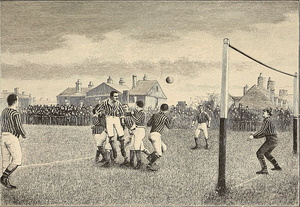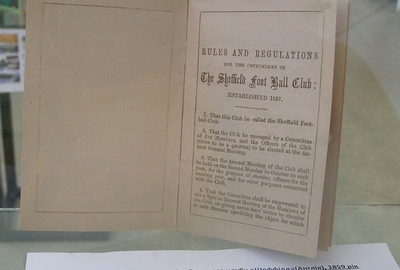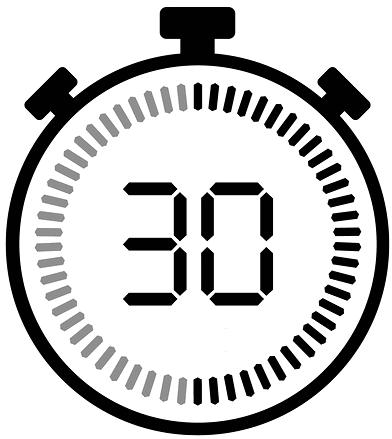 The expression ‘it’s a game of two halves’ is well-known and often used for football, but rarely is any thought put into why, exactly, those halves are the length that they are.
The expression ‘it’s a game of two halves’ is well-known and often used for football, but rarely is any thought put into why, exactly, those halves are the length that they are.
Why was 45 minutes chosen? Association football has been being played since 1846, so why did it take until 1877 for the 90 minute length of a match to be decided?
Time is such a fluid thing when it comes to football. That might sound silly, but it’s true. Matches are 90 minutes long, but how much of that is the ball actually in play for? Referees are supposed to add time on at the end of each half for injuries and other stoppages, but the amount they add on rarely reflects what’s taken place.
Here’s a look at times in the game.
Where Did 90 Minutes Come From?
 In order to understand the general manner in which timings in football work, the first place to start is with the very length of the match. After all, figuring out where 90 minutes came from in terms of how long a match should be overall will make it easier to then work out why 45 minutes was decided upon as the halfway point.
In order to understand the general manner in which timings in football work, the first place to start is with the very length of the match. After all, figuring out where 90 minutes came from in terms of how long a match should be overall will make it easier to then work out why 45 minutes was decided upon as the halfway point.
In order to know where the length of a football match came from, we have to travel back to the north of England when the game was just beginning. In the various parts of the country the different football associations were responsible for creating their own rules, with no standardised set of rules having yet been formed.
The Sheffield Rules were one of the chief ones that were used, soon spreading out of Yorkshire and to the north of England and the Midlands. In 1866 London and Sheffield went up against each other in a match and had to decide how long it should last for, with both associations having matches of different lengths at that point.
Indeed, even the concept of changing end at half-time had only been introduced to the Sheffield Rules in 1862, but even that was depending on there having been no goals scored in the first period of play. It is believed that the two teams agreed on a match of 90 minutes, with people feeling that that length was suitable as the players would be tired by the end of it.
The likelihood is that London clubs tended to play the Football Association’s rules, which set the time of a match at a shorter duration to the 2 hours that the Sheffield Association thought play should take place for. The compromise was set at 45 minutes per half for a total of 90 minutes, though even this wasn’t made official until 1897.
1877 was the year that the Sheffield Football Association and the FA decided to join forces, creating an amalgamated set of rules that would be used for all of football. Remarkably, it took another 20 years for rules to be put in place regarding both how long football matches lasted for as well as how many people were able to play on each of the participating teams.
The new law stated that football matches would last for 90 minutes unless it had otherwise been agreed by both teams prior to the game getting underway. That’s not to say that these FA rules were accepted globally, however, and it took some time before the exact timings of football as well know and understand them today were put in place everywhere.
30 Minutes Of Extra-Time
 The idea of extra-time in football was also added to the rules with those 1897 amendments, at least for British clubs and competitions. It wasn’t the case everywhere, though, which is demonstrated neatly by the German Championship final of 1922 when Hamburg and Nuremburg were drawing 2-2 after 90 minutes but wanted to find a winner.
The idea of extra-time in football was also added to the rules with those 1897 amendments, at least for British clubs and competitions. It wasn’t the case everywhere, though, which is demonstrated neatly by the German Championship final of 1922 when Hamburg and Nuremburg were drawing 2-2 after 90 minutes but wanted to find a winner.
They decided to keep playing until a team scored, resulting in another 99 minutes of football. Even then it wasn’t a goal that ended the contest so much as it was the encroachment of night. When the two sides met for a replay seven weeks later they did include extra-time, but the match still couldn’t be finished because of the number of injuries and sendings off.
We know, then, that not all countries or even competitions used the extra-time laws as laid out by the Football Association in 1897, but where did the very idea of an additional 30 minutes come from? Why 30 minutes rather than, say, play another 45? The answer isn’t an easy one to discover, with the game’s law-makers rarely feeling the need to explain themselves.
What we do know is that football was crying out for a tie-breaker to decide the result of drawn matches for years before extra-time was settled upon. Prior to 1863 some Associations used the ‘rouge’ to settle a game, which was similar to a try in rugby. Association adopted the touch down in 1866, but it was abolished within the year.
in 1923 the Laws Of The Game had this rule added to it:
A game shall be won by the team scoring the greater number of goals. If no goals have been scored, or the scores are equal at the end of the game, the game shall be drawn.
The problem was that that didn’t specify what would happen in games that needed a definitive result. In some instances, such as the 1968 European Championship semi-final, a random method like tossing a coin or drawing lots was used. This was obviously seen as unfair by the losing team, which is why extra-time became the more standardised deciding method.
Despite extra-time having been written into the Laws Of The Game in 1897, it took until 1970 for it to be accepted worldwide as the norm. It was a necessary decision, given a match between Doncaster Rovers and Stockport County in Match 1946 lasted for 3 hours and 23 minutes, which remains the record length of time for a game.
The simple truth is that it’s never really been explained why 30 minutes was decided upon as a suitable amount of extra-time. It’s likely that it was just felt to be ‘right’ by the authorities, remaining shorter than a full-half of football but long enough for a likely result to be found. Half-time had already been settled on as 15 minutes, so the number was already in the game.
The rule states that extra-time can have a 1 minute break between both halves, but that it will only be long enough for players to get a drink and change ends. Footballing authorities have long wanted the game to be as neatly encapsulated as possible, meaning that one and a half hours of play plus another half hour will likely have just felt ‘neat’.
Why Is The Half-Time Break 15 Minutes Long?
 The notion of having a half-time at all dates back to the early days of the game. One of the suspected reasons for its introduction was to allow two teams from different Associations to play against each other and use one set of rules for the first-half and a different set of rules for the second period of play. One such example was when Eton and Rugby school played each other.
The notion of having a half-time at all dates back to the early days of the game. One of the suspected reasons for its introduction was to allow two teams from different Associations to play against each other and use one set of rules for the first-half and a different set of rules for the second period of play. One such example was when Eton and Rugby school played each other.
It’s likely that the duration of this half-time period as being 15 minutes stems from those early games between Eton and Rugby. Rugby used to play rules that are more closely aligned with the modern-day version of the game named in the school’s honour, whilst Eton played a game more recognisable as association football.
We can suspect that that period of half-time was decided upon as 15 minutes because rugby union matches also have a half-time period of up to 15 minutes in matches. Interestingly, the set limit of 15 minutes for football is actually a relatively modern thing. In 2006 the rules on half-time stated the following:
“The half-time interval must not exceed 15 minutes. Competition rules must state the duration of the half-time interval. The duration of the half-time interval may be altered only with the consent of the referee”.
The clear implication there is that half-time could actually be a different length to 15 minutes, so it’s not even as though 15 minutes was set in stone; no wonder narrowing down the reason why that length of time was chosen is so tricky!
The Reasoning Behind Injury/Added Time
 Whilst injury time isn’t set into the Rules Of The Game as being a specific length, it’s interesting to note that there is a more definitive reason for why the very concept of it was even introduced in the first place.
Whilst injury time isn’t set into the Rules Of The Game as being a specific length, it’s interesting to note that there is a more definitive reason for why the very concept of it was even introduced in the first place.
In 1891 Aston Villa and Stoke City were playing each other in an English Football League match, with Villa leading 2-1.
Stoke City were given a penalty with just seconds of play remaining, but before it could be taken a Villa player kicked the ball out of the ground. By the time it was recovered the match time had elapsed and the referee blew the full-time whistle.
It was decided later in the same campaign that time could be added if a penalty needed to be taken.
The Future Of Timings In Football
 Ironically, it may actually be easier to outline the likely future of timings in football than it is to find definitive answer to its history. In 2009, for example, the International Football Association Board, which decides upon all of the laws that govern the game, had a meeting in which the idea of lengthening half-time to 20 minutes was discussed.
Ironically, it may actually be easier to outline the likely future of timings in football than it is to find definitive answer to its history. In 2009, for example, the International Football Association Board, which decides upon all of the laws that govern the game, had a meeting in which the idea of lengthening half-time to 20 minutes was discussed.
Whilst the stated logic behind this discussion was that players and officials barely had time to rest at some stadiums with half-time being 15 minutes because of how long it took to get back to the changing rooms, the more realistic reason in the minds of many was that a longer half-time would earn additional revenue.
This was based around analyse of ITV’s coverage of the 2006 World Cup, during which it was able to charge £300,000 per minute of advertising. That figure went up to £1 million per minute when England played, presenting the opportunity for nearly £5 million more by extending the period that half-time lasted for.
The idea was largely denigrated, especially by football fans, but the reasoning behind future timing changes was clear enough: it’s all about the money.
Another change to the game was discussed in 2017, with the plan being to reduce the length of a match to 60 minutes but to stop the clock every time the ball went out of play. The discussion was part of an IFAB proposal entitled ‘Play Fair!‘ and was based on the idea of players time-wasting too much. In most 90 minute matches the ball is in play for less than 60 minutes.
Once again money seemed to be the driving factor behind the decision, though this time it was more about the amount of money fans were being short-changed by rather than how much FIFA could make. Though the law never came into effect in the end, it remains a topic that modern day football fans discuss on a regular basis.
